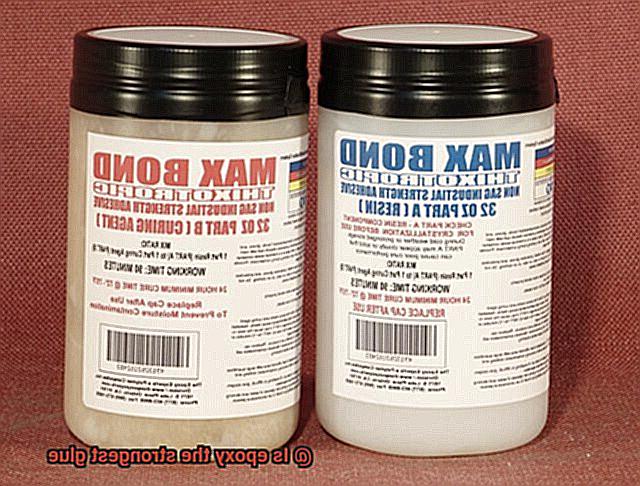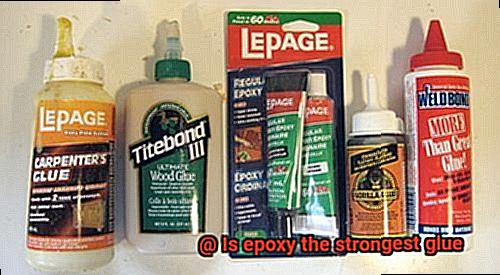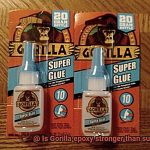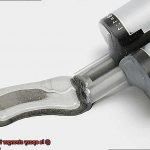Are you tired of your projects falling apart due to weak adhesive? Do you crave a bond that can withstand the toughest conditions? Look no further than epoxy.
Epoxy is the go-to adhesive for construction professionals, known for its incredible strength and durability. But what makes it so strong? Is it really the strongest glue out there?

The answer is a resounding yes. Epoxy’s superior bonding capabilities make it ideal for projects that require maximum strength. Its power comes from the chemical reaction between its two-part mixture, creating an unbreakable bond resistant to many types of damage.
But what truly sets epoxy apart is its versatility. It bonds effortlessly to almost any surface, including metals, ceramics, plastics, and even wood. This adaptability also means it can withstand water, chemicals, and high temperatures, making it perfect for long-term durability.
So whether you’re fixing a broken tool or constructing a new building, epoxy guarantees your project will remain sturdy and reliable. Stick with epoxy and experience unmatched strength in all your endeavors.
What is Epoxy?
Contents
For those seeking an adhesive with unmatched strength and versatility, look no further than epoxy. Comprised of two components, resin and hardener, epoxy creates an unbreakable bond when combined. This bond is so strong that it can withstand extreme levels of stress and weight, making it the go-to adhesive for construction, automotive, and marine industries.
The key to epoxy’s strength lies in its high tensile and shear strengths. This means that it can resist pulling or twisting forces, making it ideal for applications where a reliable bond is essential. Furthermore, epoxy can adhere to a vast array of materials, including metal, wood, plastic, glass, and even stone. Its versatility makes it a popular choice for DIY projects like crafting, woodworking, and jewelry making.
Epoxy’s resistance to water and chemicals is another advantage that sets it apart from other adhesives. It thrives in environments where moisture or chemicals are present and is commonly used in marine applications due to its ability to withstand saltwater exposure.
It’s worth noting that while epoxy is known for its strength, there are other adhesives like cyanoacrylate (super glue) or polyurethane that may be stronger in certain situations. It’s important to consider all factors before selecting the best adhesive for your project.
Factors that Determine Glue Strength
As an expert in the field, I can tell you that selecting the right type of glue is just the beginning. There are several factors that determine the strength of a glue bond, and it’s essential to consider all of them before starting any project.
Firstly, the materials being bonded together play a significant role in determining the strength of the bond. Different materials have different properties that can affect the bond’s stability. It’s crucial to choose a glue that is suitable for the materials you’re working with. For instance, bonding metal to plastic requires a different type of glue than bonding two pieces of wood together.
Another key factor is surface preparation. Any contaminants on the surface can weaken the bond and cause it to fail. To ensure maximum adhesion, it’s essential to clean and prepare the surfaces being bonded together thoroughly before applying any glue.
The type of glue used is also critical. While epoxy is known for its strength and versatility in bonding with a wide range of materials, there are other types of glue that may be even stronger in specific situations. Researching and selecting the right type of glue for your specific needs will ensure a strong and lasting bond.
Proper application technique is also crucial. Applying too much or too little glue can cause issues with the bond. Following the manufacturer’s instructions carefully will help you apply the right amount of glue in the right way.
Lastly, environmental factors such as temperature and humidity can also affect the strength of your bond. Extreme temperatures or high humidity levels can cause your bond to weaken or fail altogether.
The Strength of Epoxy
Today, we’ll be delving into the exciting world of epoxy strength. Epoxy is one of the most powerful adhesives on the market, renowned for its exceptional bonding capabilities. But what makes it so strong? Let’s explore the research and find out.
Firstly, one of the key reasons why epoxy is considered one of the strongest adhesives available is its incredible versatility. Unlike other adhesives that may struggle to bond with certain materials, epoxy can form a strong bond with almost any surface. This makes it an ideal choice for a wide range of applications, as it can be used to bond different types of materials together with ease.
In addition to its versatility, epoxy is also known for its ability to fill gaps and cracks. This ability further enhances its bonding capabilities and creates a stronger bond between surfaces. This makes it particularly useful in situations where the surfaces being bonded are not perfectly aligned or have slight imperfections.
Another factor that contributes to the strength of epoxy is its impressive resistance to stress. Epoxy can withstand different types of stress, including tensile, compressive, and shear stress. This makes it an ideal choice for applications that require high levels of strength and durability. Furthermore, epoxy has excellent resistance to water, chemicals, and UV light, which means that it can maintain its strength even in harsh environments.
It’s important to note that there are different types of epoxy adhesives available on the market, each with their own unique properties and strengths. When selecting an epoxy adhesive, you need to consider the specific application and materials involved in order to choose the best product for the job. For example, some epoxies are designed specifically for use with metals, while others are better suited for bonding wood or plastic.
Alternatives to Epoxy
While it’s a fantastic adhesive, there are other options out there that can provide an equally robust bond. As an expert in adhesives, I’ve researched and found some great alternatives to epoxy that you may want to consider.
One option is cyanoacrylate, also known as super glue. This adhesive may be small in size, but it packs a big punch when it comes to bonding power. It works quickly, forming a strong bond in just seconds. Super glue can be used on various materials, such as plastic, metal, and wood. However, it’s worth noting that it may not work well on certain surfaces.
If you’re looking for an adhesive with high water resistance and a longer working time than epoxy, polyurethane adhesive is an excellent choice. It’s perfect for materials that will be exposed to water or extreme temperatures. Polyurethane adhesive can also be helpful for more complex projects due to its extended working time.
Another option to consider is acrylic adhesives. These are often used in manufacturing and construction because of their outstanding strength and durability. They can be utilized on different surfaces such as metal, plastic, and glass.
Lastly, silicone adhesives are known for their flexibility and resistance to water and temperature changes. They are often used in automotive applications and can provide a strong bond on both porous and non-porous surfaces.
It’s important to choose the right adhesive depending on your project’s specific needs. While epoxy is undoubtedly a reliable choice, these other adhesives offer unique benefits that may make them a better fit for your project. Consider factors such as surface type, exposure to water or temperature changes, and working time when selecting an adhesive.
How to Choose the Right Glue for Your Project
Starting a new project can be exciting, but choosing the right glue can make all the difference. With so many options available, it can be overwhelming to figure out which adhesive will work best for your specific needs. Here are some factors to consider when selecting the perfect glue for your project.
Assess Your Materials
Before selecting a glue, it’s essential to assess the materials you’ll be bonding together. Some glues work better on certain materials than others, such as wood glue for wood or fabric glue for textiles. By choosing a compatible adhesive, you’ll ensure a strong and durable bond.
Consider Strength Requirements
The strength of the bond required is another crucial factor to consider. High-stress projects like repairing car parts or building furniture require an adhesive with exceptional bonding strength, such as epoxy. For more delicate projects like scrapbooking or crafting, a lighter adhesive like double-sided tape may suffice.
Evaluate Drying Time
Drying time can impact how quickly you can move on to the next step of your project. If you need precision and accuracy or want to finish your project quickly, then selecting a quick-drying glue may be preferable. On the other hand, if you have more time to spare and want maximum bonding strength, then selecting a slower-drying adhesive may be a better option.
Safety First
Some types of glue may emit fumes or require special handling procedures, so it’s crucial to read all instructions and warnings carefully before use. Be sure to select an adhesive that is appropriate for your safety concerns and follow the recommended handling procedures.
Read the Label and Instructions Carefully
Different types of adhesive require different application techniques. It’s essential to read the label and instructions carefully before using any glue to ensure that you’re applying it correctly. For example, some adhesives work best when applied to both surfaces before being pressed together, while others should only be applied to one surface.
Experiment with Different Types of Glue
If you’re not sure which adhesive to use, try testing a few different types on a small section of your project to see which one works best. By experimenting with different types of glue, you can find the perfect adhesive for your project.
Advantages and Disadvantages of Using Epoxy
Look no further than epoxy. Known for its powerful bonding capabilities, epoxy can be used on a variety of surfaces such as wood, metal, concrete, and plastic. Not only does it create a durable bond that can withstand heavy loads and extreme temperatures, but it is also versatile for various applications such as flooring, construction, automotive, and marine industries.
One of the most significant advantages of using epoxy is its waterproof properties. It is resistant to water, making it perfect for use in wet environments such as swimming pools or bathrooms. Additionally, epoxy is resistant to chemicals such as acids, bases, and solvents, making it ideal for industrial applications.
Despite all these benefits, there are some downsides to consider. Epoxy requires at least 24 hours to cure before it can be sanded or painted. Also, some types of epoxy contain harmful chemicals that can cause skin irritation or respiratory problems if not handled properly.
Another disadvantage is the cost. Epoxy can be more expensive than other types of adhesives, making it less cost-effective for small projects. Once epoxy has cured, it can also be difficult to remove from surfaces without damaging them. Finally, applying epoxy can be messy and time-consuming if not done properly.
Tips for Working with Epoxy
When it comes to working with epoxy, there are a few critical steps that you should never skip. Here are five sub-sections that will help you understand the importance of preparing your workspace and wearing protective gear when working with epoxy:
Workspace Preparation
Before starting your epoxy project, it’s crucial to prepare your workspace. Cover your work surface with plastic or newspaper to protect it from spills and drips. Make sure your workspace is well-ventilated, as epoxy can emit strong fumes that can be harmful if inhaled.
Protective Gear
Epoxy can be hazardous to your health if it comes into contact with your skin or eyes. Always wear gloves and safety glasses when working with epoxy to protect yourself from accidental exposure.
Accurate Measurements
Epoxy typically comes in two components – a resin and a hardener – that must be mixed together in the right ratio for the adhesive to work properly. Using a scale or measuring cup can help ensure accuracy when measuring the components.
Thorough Mixing
Mixing the two components together thoroughly is essential for creating a successful bond. Use a stir stick or scraper to blend the two components until they are completely combined. Mixing for at least two minutes will ensure that the epoxy is evenly mixed.
Even Application
When applying epoxy, it’s essential to apply it evenly over the surface you’re bonding. Using a brush or spatula can help spread the adhesive evenly, and avoid gaps or air bubbles. Applying thin layers of epoxy rather than one thick layer can also help ensure even application.
Safety Considerations When Working with Epoxy
While epoxy is a popular adhesive known for its strength and durability, it’s important to prioritize safety when working with this potent substance. In this article, we’ll cover essential safety considerations to keep in mind when handling epoxy.
Protective Gear: The Necessity
The first and most critical consideration when working with epoxy is protective gear. This adhesive contains chemicals that can be harmful if they come into contact with your skin or eyes. Fumes from the adhesive can also be dangerous if inhaled. Therefore, it’s essential to wear protective gear, including gloves, safety glasses, and a respirator mask. These items will help protect you from any potential harm from the chemicals in epoxy.
Well-Ventilated Area: The Need
Another critical safety consideration when working with epoxy is ensuring proper ventilation in the workspace. The fumes emitted by the adhesive can be harmful if inhaled for an extended period. Therefore, it’s recommended to work outdoors or in an area equipped with proper ventilation. This will help you avoid inhaling the fumes and ensure that the workspace is safe for everyone involved.
Follow the Manufacturer’s Instructions: The Key
Each brand of epoxy may have specific instructions on how to handle the adhesive safely. Therefore, it’s crucial to read and understand the label thoroughly before using the product. Make sure you follow all of the instructions carefully before starting your project to ensure that you’re using the product correctly and safely.
Clean Up Spills Immediately: The Reminder
Lastly, it’s essential to clean up any spills or drips immediately when working with epoxy. Epoxy can be challenging to remove once it dries out, so it’s crucial to clean up any spills before they dry out. Be sure to have paper towels or rags on hand to clean up any spills or drips that occur during your project.
XObmZIbHOzY” >
Also Read: What Is the Best Epoxy Glue?
Conclusion
In conclusion, epoxy stands out as one of the toughest adhesives on the market. Its exceptional bonding abilities and adaptability make it a top choice for construction professionals, DIY enthusiasts, and anyone in need of a dependable bond that can endure harsh conditions. The secret behind epoxy’s strength lies in its two-part mixture that creates an unbreakable bond resistant to various types of damage.
However, when selecting an adhesive for your project, it’s crucial to consider all factors that determine glue bond strength. These include surface preparation, materials being bonded together, proper application technique, type of glue used, and environmental factors such as temperature and humidity.
Although known for its durability and robustness, epoxy may not always be the strongest adhesive option available. Other adhesives like cyanoacrylate or polyurethane could be more effective in specific situations. Therefore, it’s essential to select the right type of glue based on your project’s specific needs.
When using any adhesive like epoxy, safety should always come first. Prioritize safety by wearing protective gear and working in a well-ventilated area. Following the manufacturer’s instructions carefully and cleaning up spills immediately can also help ensure safe handling.
In summary, epoxy ranks among the most potent adhesives available today.






